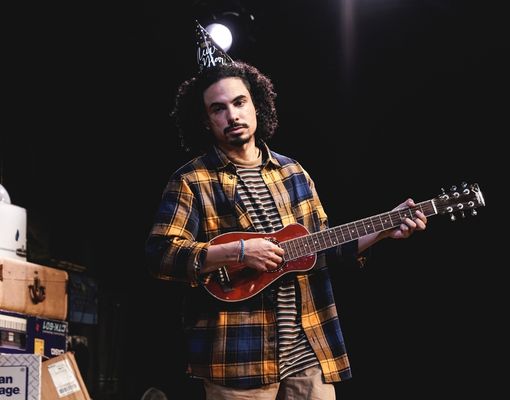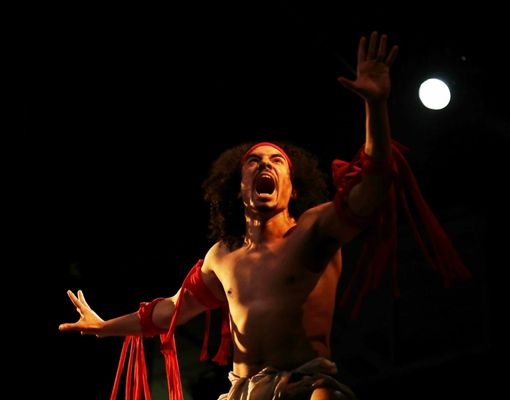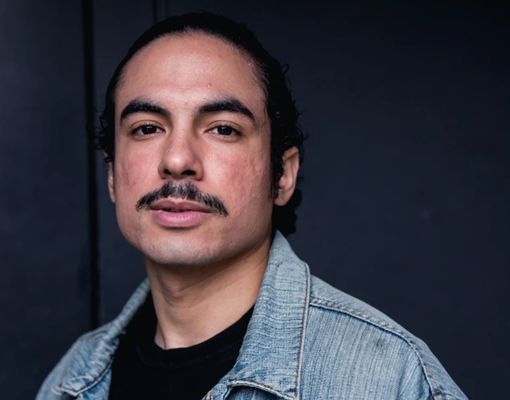
Meisner Teacher John Maria Gutierrez – #TKSConversation
John Maria Gutierrez discusses his love for Experimental Theater, and how he came to teach the Meisner Technique at Terry Knickerbocker Studio:

John Maria Gutierrez – a multidisciplinary actor, dancer, creator, and educator, who teaches the Meisner technique at the Terry Knickerbocker Studio – was the first person in his family to be born in the United States. He didn’t learn English until he was seven years old. His love of experimental theater stems in part from his search for a universal language that doesn’t rely solely on words. His teaching of the Meisner technique, which he found especially challenging as a student, is now a cornerstone of that continuing quest.
TKS: How did your fascination with experimental theater evolve?
John: It evolved from a combination of my academic pursuits and my background. I was born in New York City’s Washington Heights. My parents were from the Dominican Republic, and we spoke Spanish at home. As I learned my way in New York – without learning English until I was seven – I found how faulty language is: how easily it’s misunderstood and misinterpreted; how often it’s inadequate on its own and how eloquent it can be when combined with other forms of expression. When I later attended New York University, I became enthralled with experimental theater, because it grapples with that same core question: How can we best express ourselves?
TKS: What do you mean when you say “experimental theater”?
John: I mean two things that are somewhat contradictory. First, theater that is willing to take chances, that isn’t formulaic, that thrives on combining forms of expression in ways that are not traditional. But the contradiction is that I think all theater is, at its core, experimental. Every time we go on stage, we are experimenting with our own conceptions of our performance. Every playwright, every director, every creator of a show is innovating. So, my love of experimental theater, in a sense, includes all theater, because it’s the process of creating that fascinates me. I had a drama teacher in high school who asked, “Why would you do anything that’s been done before?” I love that question, and it has energized my approach to theater ever since.
TKS: You were a student at the Terry Knickerbocker Studio, and now you are a faculty member. How did that happen?
John: I met Terry Knickerbocker in my first year at NYU. He was one of my drama teachers, and I was struggling with the Meisner technique. My upbringing and background just didn’t lend themselves to the openness that Meisner requires. Terry recognized my guardedness – the armor that I was wearing – and we talked about it. In that exchange, I felt “seen,” and I always held on to that moment.

I studied with Terry again in my second year at NYU, and I continued to interact with him throughout my undergraduate years. He was one of the few teachers I’ve had who always kept tabs on me. He would check on me every now and then to see if my inner actor was being fed. After I graduated from NYU with a BFA in drama, I began dancing and performing in movement theater and experimental theater – touring nationally and internationally. I enjoyed the experience, but it felt inconsistent.

I talked with Terry, because he had had a lot of experience in experimental theater, and he asked, “How wide a skill set do you want?” I realized then that I missed acting and wanted to enhance my acting skills, so I enrolled in the two-year program at the Terry Knickerbocker Studio. As my acting career subsequently evolved and the breadth of my credentials as a performer grew, Terry asked me to join the Terry Knickerbocker Studio as a faculty member. I think he recognized in part that my initial experience with the Meisner technique would be an asset in teaching it, because I knew first-hand what a struggle it can be for students to open themselves up enough to allow their entire being to become an instrument of self-expression.
TKS: Your career has been remarkably broad: dance, singing, movement theater, experimental theater, La MaMa E.T.C., NBC’s “Law and Order: SVU,” and the upcoming film “A Thousand and One.” How do you see those experiences interconnecting?
John: What I prize is the process of creation, and that’s the common thread, but the experience of working in various art forms is much more closely connected than that. The person who essentially cast me on “Law & Order: SVU” saw me in an Off-Off Broadway production at La MaMa E.T.C. On ”SVU,” I worked closely with Ice-T, who began his career as an underground rapper. And all of my scenes in “A Thousand and One” are with Teyana Taylor, who began her career at the age of 15 choreographing the music video for Beyoncé’s hit single “Ring the Alarm.”
TKS: How does that breadth of experience inform your teaching at the Terry Knickerbocker Studio?
John: I draw on that experience to focus students on the truthfulness of something coming into being. As a teacher, I ask: “How is it that you express yourself?” I facilitate a process of imagination and allow it to expand. That expansion is a function of each student’s reality – just as it has been of my own. The resulting exploration is how artistry emerges.
Join our Spring Acting Intensive and work alongside John Maria Gutierrez.
LEARN MORE ABOUT JOHN MARIA GUTIERREZ: